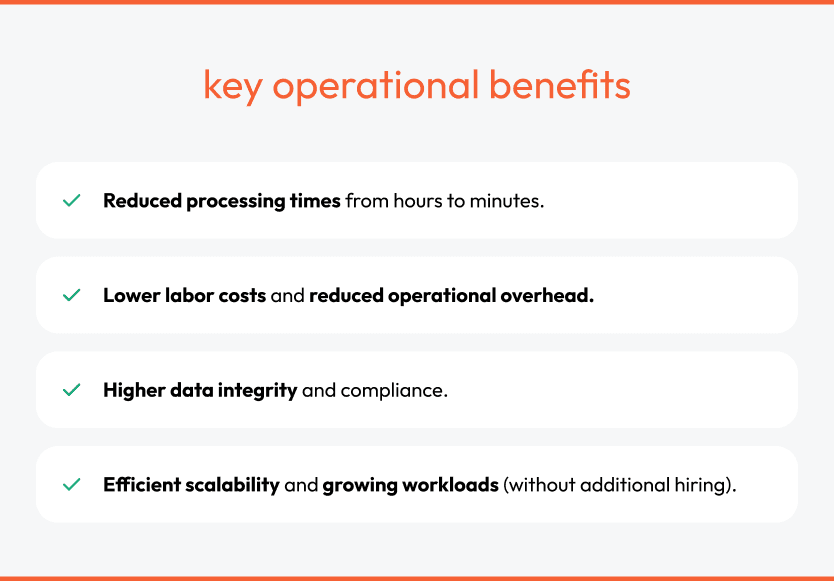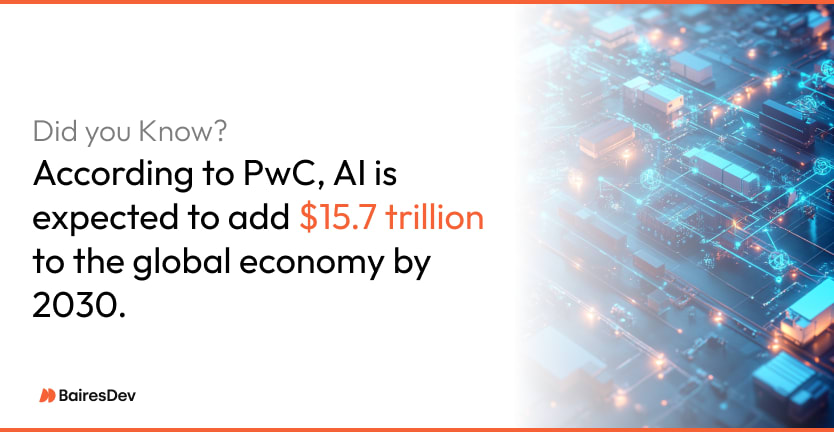Companies that master software in business are outperforming others on key metrics like customer acquisition costs and time-to-market. With the growing complexity of technology implementations, many organizations are turning to staff augmentation strategies to quickly access specialized talent for these critical initiatives. This approach makes sense because expert tech professionals can help implement five specific technologies that are driving the biggest competitive advantages today. We’ve analyzed these technologies along with practical ways to implement them and the substantial gains that come with deploying them effectively.
Intelligent Automation
Modern businesses face routine tasks prone to inefficiencies, high costs, and human errors on the daily. That’s where intelligent automation comes in, leveraging AI-driven workflows, Robotic Process Automation (RPA), and Intelligent Document Processing (IDP). It streamlines operations by eliminating bottlenecks and creating an adaptable environment where data-intensive operations and repetitive tasks are automated with the help of human oversight.
Among the key operational benefits are:

Instead of wasting talent on routine work, you can reallocate most employees to where they actually move the needle.

Harnessing Machine Learning
Most businesses operate in a data-rich environment, yet raw information alone lacks strategic value and remains underutilized without machine learning (ML)-powered data analytics.
ML algorithms process complex datasets using pattern recognition, anomaly detection, as well as predictive modeling for businesses to uncover detailed insights that drive strategic decisions. Yet, each of these relies on different ML methodologies:
- Supervised learning models use labeled historical data to improve forecasting accuracy.
- Unsupervised learning techniques analyze patterns in unlabeled data to identify trends and hidden correlations in real time.
- Reinforcement learning further optimizes data-driven decision-making by continuously adjusting strategies based on evolving market conditions.
With that in mind, several AI-driven analytics solutions integrate ML into enterprise software to power:
- Real-time demand forecasting – using predictive analytics and ML-enhanced time-series modeling to keep supply chains running smoothly.
- Dynamic pricing models – adjusting prices on the fly based on demand shifts and competitive advantage to maximize revenue.
- Fraud and anomaly detection – spotting suspicious transactions in real time using unsupervised machine learning models.
Optimizing Business Operations with Cloud Computing and Scalability
Emerging cloud technology in the business world has accelerated the shift from CapEx-heavy on-prem infrastructure to OpEx-driven cloud environments. The goal is clear: cut costs while increasing flexibility and resilience.
However, traditional data centers demand high upfront investments in hardware, maintenance, and infrastructure scaling. The bottlenecks they create, in turn, force companies to overprovision resources or risk performance issues.
Cloud-native architectures solve this by allowing businesses to allocate resources on demand, automate scaling, and eliminate wasted capacity. They also provide the flexibility to integrate emerging technologies like AI, blockchain, and quantum computing, ensuring businesses remain at the forefront of innovation. To do this, cloud-native architectures rely on:
- Distributed computing – distributes workloads across multiple servers or data centers to enhance performance.
- Serverless frameworks – run code execution without provisioning or managing infrastructure, enabling developers to focus on application logic.
- Container orchestration – manages and automates containerized workloads for efficient resource allocation, load balancing, and high availability across environments.
- Edge computing – optimizes data storage by processing information closer to the source. This reduces latency and offloads network congestion for real-time applications like IoT and Artificial Intelligence inference.
- API-driven integrations – enabling communication technology between micro services, external platforms, enterprise systems, and video conferencing tools.
Quality Assurance Testing & Automation
We’re all aware that software is at the core of modern technology in business. That said, it can introduce more problems than solutions without rigorous testing.
When performing quality assurance on software, verify that applications work as intended and remain secure. They should scale, integrate with other systems, and perform efficiently under various conditions. Although this can be done manually, it’d be relatively slow, prone to error, and expensive, too.
Instead, you’re better off employing automated QA testing and running pre-defined test cases across different devices and configurations. This is especially pressing in cases where businesses rely on continuous integration and continuous deployment (CI/CD) to push updates rapidly.
There are multiple types of automated testing you can apply throughout your development cycle, for example:
- Unit testing – verifies individual functions in isolation.
- Integration testing – ensures different modules work together as expected.
- Regression testing – identifies unintended changes or bugs after updates.
- Performance testing – evaluates scalability and load handling.
- Security testing – detects vulnerabilities before deployment.
Also, automated QA has no trouble integrating with CI/CD tools like Jenkins, GitHub Actions, and GitLab CI/CD. It transforms business operations by cutting testing time from days to minutes and accelerating release cycles. It also improves software reliability and prevents UI/UX issues from reaching production.
Cybersecurity & Zero Trust Architecture
Along with technology in business, cybersecurity is crucial. Cyber threats are continuously evolving. Check Point reports that attacks jumped 44% in 2025 alone. Traditional perimeter-based security models are nearly obsolete in preventing breaches. They fail to stop disruptions, protect customer trust, and prevent financial losses.
Instead, there’s the Zero Trust Architecture (ZTA) framework. It eliminates implicit trust by enforcing continuous authentication and real-time threat detection at every layer of an organization’s infrastructure. Every access request is continuously verified, regardless of origin.
Such software-driven cybersecurity would include the following key components:
- Cybersecurity risk assessment – conducts automated vulnerability scanning utilizing Qualys, Nessus, and OpenVAS to identify weaknesses in applications, networks, and endpoints.
- Intrusion detection & response (IDR) – uses Wireshark, Snort, and Suricata to analyze network traffic and detect anomalies. While Wireshark is primarily a network protocol analyzer, Snort and Suricata function as intrusion detection systems capable of real-time traffic analysis and threat detection.
- Endpoint detection & response (EDR) – deploys AI-powered Carbon Black solutions for continuous endpoint monitoring and behavioral threat analysis.
- Governance, risk, & compliance (GRC) – implements frameworks like RSA Archer and ServiceNow GRC to streamline compliance (ISO 27001, GDPR, HIPAA) and automate policy enforcement.
- Penetration testing & threat simulation – leverages tools like NMap and Metasploit, tools to execute controlled cyberattacks and expose crucial vulnerabilities in corporate infrastructure before real adversaries can exploit them.
The Future of Information Technology in Business
The role of technology in business keeps expanding, and the competitive edge now comes from how effectively you implement it. Intelligent automation, ML, cloud computing, QA automation, and cybersecurity are already optimizing efficiency—but what’s next?
Staying ahead means optimizing every available resource to work smarter for your business, from maximizing efficiency and streamlining operations to enhancing customer experiences.







